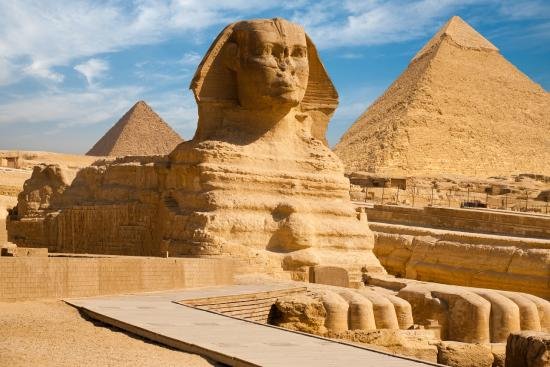Ancient Egypt lies in the eastern basin of the Mediterranean Sea, and the presence of many quantities of silt resulting from the continuous floods of the Nile helped to make its land fertile and suitable for agriculture. Therefore, many different species, which were united by the pharaoh Mena and the beginning of what is known as Egyptian civilization, which is considered one of the oldest civilizations found on Earth. The Egyptian civilization was concentrated on the banks of the Nile, which began to be established in 3150 BC. King Mena united Egypt and Upper Egypt and its subsequent development over the years. Egyptian civilization reached its peak in the modern state until Roman rule.
Historical Stations of Egyptian Civilization Egypt has been governed by many families since 3000 BC, and historical stations can be divided into three historical stages: the era of the ancient empire: whose capital was Memphis, which was characterized by the construction of pyramids and continued from 3000 BC to 2100 B.C. The Age of Modern Empire: Its capital is good. The era of decadence: the beginning of the attacks and the external invasion and the Roman occupation of Egypt. Egyptian society is the Egyptian society during the ancient Egyptian civilization in a hierarchical way, so that the pharaoh sits at the top and is considered a holy god, followed by the rest of the people according to the following division: Book category: whose function is to help the Pharaoh to run the affairs of society
. Class priests: They play the role of mediator between people and gods.
The class of craftsmen and peasants: They are responsible for providing the obligations of the country's agricultural and industrial elements
. The layer of soldiers: who are working to protect the country and defend it against external attacks
. The class of slaves and captives: They are the class that has no rights at all
. Pyramids in Egyptian Civilization:
The pyramid is known as a royal burial place built on the shape of a mountain of carved stone, which is brought from the mountains of the Arabian Peninsula through the Nile and the Sahara. It took the pyramids to build up to 30 years for each pyramid and thousands of workers and slaves working in very poor conditions, The pyramid consists of a main entrance and a group of passages leading to the burial chambers
. The most important achievements of Egyptian civilization!
Provide the necessary materials to live using the available minerals in the valley and the desert areas nearby
. Develop a separate writing system
. Organization of collective construction and agricultural projects. Activation of agriculture
. Strengthening the military defense forces against the enemies, in order to assert the pharaonic control over the country.
Election of a group of bureaucrats, clerics and administrators to work under the control of the Pharaoh. The exploitation of quarries and the development of building techniques that helped them to build huge pyramids in addition to building temples and estates.
Development of irrigation systems and agricultural production techniques.
The Pharaohs are the first ship-makers, and the technology of painting on glass
. The first known peace treaty dates back to the Egyptian civilization
. It is the only civilization that has left a lasting legacy.
Historical Stations of Egyptian Civilization Egypt has been governed by many families since 3000 BC, and historical stations can be divided into three historical stages: the era of the ancient empire: whose capital was Memphis, which was characterized by the construction of pyramids and continued from 3000 BC to 2100 B.C. The Age of Modern Empire: Its capital is good. The era of decadence: the beginning of the attacks and the external invasion and the Roman occupation of Egypt. Egyptian society is the Egyptian society during the ancient Egyptian civilization in a hierarchical way, so that the pharaoh sits at the top and is considered a holy god, followed by the rest of the people according to the following division: Book category: whose function is to help the Pharaoh to run the affairs of society. Class priests: They play the role of mediator between people and gods. The class of craftsmen and peasants: They are responsible for providing the obligations of the country's agricultural and industrial elements. The layer of soldiers: who are working to protect the country and defend it against external attacks. The class of slaves and captives: They are the class that has no rights at all. Pyramids in Egyptian Civilization The Pyramid is known as a royal burial place built on the shape of a mountain of carved stone, which is brought from the mountains of the Arabian Peninsula through the Nile and the Sahara. It took the pyramids to build up to 30 years for each pyramid, and thousands of workers and slaves who work. In very poor conditions, the pyramid consists of a main entrance and a group of passages leading to the burial chambers. The most important achievements of the Egyptian civilization provide the necessary materials to live by exploiting minerals available in the valley and nearby desert areas. Develop a separate writing system. Organization of collective construction and agricultural projects. Activation of agriculture. Strengthening the military defense forces against the enemies, in order to assert the pharaonic control over the country. Election of a group of bureaucrats, clerics and administrators to work under the control of the Pharaoh. The exploitation of quarries and the development of building techniques that helped them to build huge pyramids in addition to building temples and estates. Development of irrigation systems and agricultural production techniques. The Pharaohs are the first ship-makers, and the technology of painting on glass. The first known peace treaty dates back to the Egyptian civilization. It is the only civilization that has left a lasting legacy.
good poste mon ami
تم لك حبيبي الغالي
Thanks
merci de votre aide